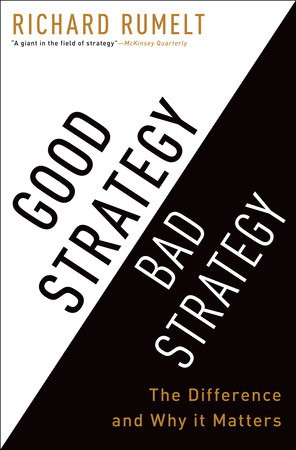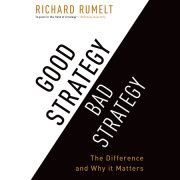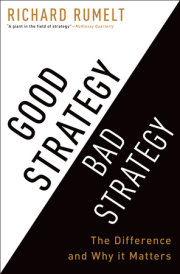CHAPTER ONE
GOOD STRATEGY IS UNEXPECTED
The first natural advantage of good strategy arises because other organizations often don’t have one. And because they don’t expect you to have one, either. A good strategy has coherence, coordinating actions, policies, and resources so as to accomplish an important end. Many organizations, most of the time, don’t have this. Instead, they have multiple goals and initiatives that symbolize progress, but no coherent approach to accomplishing that progress other than “spend more and try harder.”
APPLE
After the 1995 release of Microsoft’s Windows 95 multimedia operating system, Apple Inc. fell into a death spiral. On February 5, 1996,
BusinessWeek put Apple’s famous trademark on its cover to illustrate its lead story: “The Fall of an American Icon.”
CEO Gil Amelio struggled to keep Apple alive in a world being rapidly dominated by Windows-Intel-based PCs. He cut staff. He reorganized the company’s many products into four groups: Macintosh, information appliances, printers and peripherals, and “alternative platforms.” A new Internet Services Group was added to the Operating Systems Group and the Advanced Technology Group.
Wired magazine carried an article titled “101 Ways to Save Apple.” It included suggestions such as “Sell yourself to IBM or Motorola,” “Invest heavily in Newton technology,” and “Exploit your advantage in the K–12 education market.” Wall Street analysts hoped for and urged a deal with Sony or Hewlett-Packard.
By September 1997, Apple was two months from bankruptcy. Steve Jobs, who had cofounded the company in 1976, agreed to return to serve on a reconstructed board of directors and to be interim CEO. Die-hard fans of the original Macintosh were overjoyed, but the general business world was not expecting much.
Within a year, things changed radically at Apple. Although many observers had expected Jobs to rev up the development of advanced products, or engineer a deal with Sun, he did neither. What he did was both obvious and, at the same time, unexpected. He shrunk Apple to a scale and scope suitable to the reality of its being a niche producer in the highly competitive personal computer business. He cut Apple back to a core that could survive.
Steve Jobs talked Microsoft into investing $150 million in Apple, exploiting Bill Gates’s concerns about what a failed Apple would mean to Microsoft’s struggle with the Department of Justice. Jobs cut all of the desktop models—there were fifteen—back to one. He cut all portable and handheld models back to one laptop. He completely cut out all the printers and other peripherals. He cut development engineers. He cut software development. He cut distributors and cut out five of the company’s six national retailers. He cut out virtually all manufacturing, moving it offshore to Taiwan. With a simpler product line manufactured in Asia, he cut inventory by more than 80 percent. A new Web store sold Apple’s products directly to consumers, cutting out distributors and dealers.
What is remarkable about Jobs’s turnaround strategy for Apple is how much it was “Business 101” and yet how much of it was unanticipated. Of course you have to cut back and simplify to your core to climb out of a financial nosedive. Of course he needed up-to-date versions of Microsoft’s Office software to work on Apple’s computers. Of course Dell’s model of Asian supply-chain manufacturing, short cycle times, and negative working capital was the state of the art in the industry and deserved emulation. Of course he stopped the development of new operating systems—he had just brought the industry’s best operating system with him from NeXT.
The power of Jobs’s strategy came from directly tackling the fundamental problem with a focused and coordinated set of actions. He did not announce ambitious revenue or profit goals; he did not indulge in messianic visions of the future. And he did not just cut in a blind ax-wielding frenzy—he redesigned the whole business logic around a simplified product line sold through a limited set of outlets.
In May 1998, while trying to help strike a deal between Apple and Telecom Italia, I had the chance to talk to Jobs about his approach to turning Apple around. He explained both the substance and coherence of his insight with a few sentences:
The product lineup was too complicated and the company was bleeding cash. A friend of the family asked me which Apple computer she should buy. She couldn’t figure out the differences among them and I couldn’t give her clear guidance, either. I was appalled that there was no Apple consumer computer priced under $2,000. We are replacing all of those desktop computers with one, the Power Mac G3. We are dropping fi ve of six national retailers—meeting their demand has meant too many models at too many price points and too much markup.
This kind of focused action is far from the norm in industry. Eighteen months earlier, I had been involved in a large-scale study, sponsored by Andersen Consulting, of strategies in the worldwide electronics industry. Working in Europe, I carried out interviews with twenty-six executives, all division managers or CEOs in the electronics and telecommunications sector. My interview plan was simple: I asked each executive to identify the leading competitor in their business. I asked how that company had become the leader—evoking their private theories about what works. And then I asked them what their own company’s current strategy was.
These executives, by and large, had no trouble describing the strategy of the leader in their sectors. The standard story was that some change in demand or technology had appeared—a “window of opportunity” had opened—and the current leader had been the first one to leap through that window and take advantage of it. Not necessarily the fi rst mover, but the first to get it right.
But when I asked about their own companies’ strategies, there was a very different kind of response. Instead of pointing to the next window of opportunity, or even mentioning its possibility, I heard a lot of look-busy doorknob polishing. They were making alliances, they were doing 360-degree feedback, they were looking for foreign markets, they were setting challenging strategic goals, they were moving software into firmware, they were enabling Internet updates of firmware, and so on. They had each told me the formula for success in the 1990s electronics industry—take a good position quickly when a new window of opportunity opens—but none said that was their focus or even mentioned it as part of their strategy.
Given that background, I was interested in what Steve Jobs might say about the future of Apple. His survival strategy for Apple, for all its skill and drama, was not going to propel Apple into the future. At that moment in time, Apple had less than 4 percent of the personal computer market. The de facto standard was Windows-Intel and there seemed to be no way for Apple to do more than just hang on to a tiny niche.
In the summer of 1998, I got an opportunity to talk with Jobs again. I said, “Steve, this turnaround at Apple has been impressive. But everything we know about the PC business says that Apple cannot really push beyond a small niche position. The network effects are just too strong to upset the Wintel standard. So what are you trying to do in the longer term? What is the strategy?”
He did not attack my argument. He didn’t agree with it, either. He just smiled and said, “I am going to wait for the next big thing.”
Jobs did not enunciate some simple-minded growth or market share goal. He did not pretend that pushing on various levers would somehow magically restore Apple to market leadership in personal computers. Instead, he was actually focused on the sources of and barriers to success in his industry—recognizing the next window of opportunity, the next set of forces he could harness to his advantage, and then having the quickness and cleverness to pounce on it quickly like a perfect predator. There was no pretense that such windows opened every year or that one could force them open with incentives or management tricks. He knew how it worked. He had done it before with the Apple II and the Macintosh and then with Pixar. He had tried to force it with NeXT, and that had not gone well. It would be two years before he would make that leap again with the iPod and then online music. And, after that, with the iPhone.
Steve Jobs’s answer that day—“to wait for the next big thing”—is not a general formula for success. But it was a wise approach to Apple’s situation at that moment, in that industry, with so many new technologies seemingly just around the corner.
DESERT STORM
Another example of surprise at the existence of a strategy occurred at the end of the first Gulf War in 1991. People were surprised to discover that U.S. commanders actually had a focused strategy for defeating the entrenched Iraqi invaders.
On August 2, 1990, Iraq invaded Kuwait. Led by elite troops making airborne and amphibious landings, and four divisions of the Republican Guard, 150,000 Iraqi soldiers rolled into and occupied Kuwait. It is probable that Saddam Hussein’s primary motive for the invasion was fi nancial. The eight-year war he had started by invading Iran in 1980 had left his regime with massive debts to Kuwait and other Gulf states. By taking Kuwait and declaring it the nineteenth province of Iraq, Saddam would cancel his debts to that country and be able to use its massive oil income to repay his debts to other nations.
Five months later, a thirty-three-nation coalition organized by U.S. president George H. W. Bush was carrying out air strikes against Iraqi forces and rapidly building its ground forces. Iraq, in turn, had increased its force in Kuwait to more than five hundred thousand. It was hoped that air power alone might produce a resolution of the conflict, but if it did not, a ground offensive would be necessary to reverse Iraq’s invasion and occupation of Kuwait.
There was no real doubt that the coalition had the ability to throw back the Iraqis. But how costly would it be? In October 1990, the French newspaper
L’Express had estimated that retaking Kuwait would take about a week and cost twenty thousand U.S. casualties. As Iraqi forces swelled and built defensive positions, public discussion in the press, on television, and in the halls of Congress began to evoke images of World War I trench combat. In Congress, Senator Bob Graham (D-Florida) noted that “Iraq already has had five months to dig in and to fortify and they have done so in a major way. Kuwait has fortifi cations reminiscent of World War I.” In the same vein, the
New York Times described a battalion of the Sixteenth Infantry as “the men who expect to have the job of slogging it out in the trenches of Kuwait with their M-16 rifles and M-60 machine guns blazing.”
Time magazine described the Iraqi defenses this way:
In an area about the size of West Virginia the Iraqis have poured 540,000 of their million-man army and 4,000 of their 6,000 tanks, along with thousands of other armored vehicles and artillery pieces. . . . Iraqi units are entrenched in their now traditional triangular forts, formed of packed sand, with an infantry company equipped with heavy machine guns holding each corner. Soldiers are protected by portable concrete shelters or dugouts of sheet metal and sand. Tanks are hull deep in the ground and bolstered with sandbags. Artillery pieces are deployed at the apex of each triangle, pre-aimed at “killing zones” created by fl aming trenches and minefi elds.1
On the eve of the ground assault, the
Los Angeles Times reminded its readers that “Iraqi troops along the front lines are well dug in, and assaulting such fortified positions is always a risky business. The debacles at Cold Harbor, the Somme and Gallipoli are grim reminders of the price of failure. Even success, as at Tarawa, Okinawa or Hamburger Hill, can come at a terrible price.”2
What these commentators did not predict was that General Norman Schwarzkopf, commander in chief of U.S. Central Command, had a strategy for the ground war, a strategy he had developed back in early October.
The original plan generated by his staff, a direct attack into Kuwait, was estimated to cost 2,000 dead and 8,000 wounded. Schwarzkopf rejected this approach in favor of a two-pronged plan. Air attacks would be used to reduce the Iraqi capabilities by 50 percent. Then he planned a massive secret “left hook.” While the world’s attention was focused on CNN’s 24/7 coverage of troops just south of Kuwait, the coalition would secretly shift a force of 250,000 soldiers well west of Kuwait and then have them move north into positions in the empty desert of southern Iraq. When the ground war began, this force would continue north and then turn east, completing the “left hook,” and slamming into the fl ank of the Iraqi Republican Guard. Attacks aimed northward into Kuwait itself were to be minor. The U.S. Marines ground forces were ordered to move slowly northward into Kuwait, a ploy to entice the entrenched Iraqis southward and out of their fortifications, where they would be hit from the side by part of the massive left hook. The sea-based marines would not land, their floating presence being a diversion.
Schwarzkopf’s combined-arms left-hook strategy was so successful that the intense ground war lasted only one hundred hours. A month of air bombardment had conditioned Iraqi troops to disperse and hide their tanks and artillery, stay out of their vehicles, and keep motors off. The swiftness and violence of the coalition ground assault, combining tanks, infantry, attack helicopters, and bombers, was decisive. Republican Guard units fought bravely but were unable to maneuver or call in reserves fast enough to respond to the speed and ferocity of the attack. Finally, and perhaps most important, Saddam Hussein had ordered his commanders not to use their chemical weapons. These artillery shells, used to halt Iranian attacks during the Iran-Iraq War, would have caused thousands of coalition casualties. Marine commanders had estimated they would lose 20 to 30 percent of their force if chemical weapons were used against them.3 But Saddam was deterred—postwar intelligence gleaned from the Russians revealed that he feared a U.S. nuclear retaliation to such use.
Iraq fled Kuwait, much of its invading army destroyed.4 Coalition casualties were light—on the first day there were eight dead and twenty-seven wounded. The coalition’s success with the combined-arms left-hook strategy was so stark that pundits who were worried about trench warfare in February were, by March, opining that the coalition had amassed more forces than it needed and that the outcome had been a foregone conclusion.
Schwarzkopf revealed the ground-war strategy to the public in a widely viewed press briefing. Most people who saw this briefing and the map of the left hook were surprised and impressed. News commentators described the plan as “brilliant” and “secret.” Few had anticipated this envelopment maneuver. But why hadn’t they? The Department of the Army publishes field manuals fully describing its basic doctrines and methods. FM 100-5, published in 1986, was titled
Operations and was described as “the Army’s keystone warfighting manual.” Part 2 of FM 100-5 was dedicated to “Offensive Operations,” and on page 101 it described “envelopment” as the most important form of offensive maneuver—the U.S. Army’s “Plan A.” The manual said:
Envelopment avoids the enemy’s front, where its forces are most protected and his fires most easily concentrated. Instead, while fixing the defender’s attention forward by supporting or diversionary attacks, the attacker maneuvers his main effort around or over the enemy’s defenses to strike at his flanks and rear.
To illustrate this maneuver, FM 100-5
Operations offered a diagram reproduced on the facing page.
Given this vivid picture of a feint up the middle combined with a powerful “left hook,” one must ask:
“How could Schwarzkopf’s use of the primary offensive doctrine of the U.S. Army have been a surprise to anyone?” Some part of the answer lies in successful deception. Schwarzkopf intended to make it appear that the main attack would be launched into Kuwait from the sea and then overland directly into Iraqi defenses. This was supported by an early visible amphibious raid on the Kuwaiti coast and by actions to destroy Iraq’s navy. The press unwittingly helped in this misdirection by reporting on the photogenic amphibious training, the build-up of troops just south of Kuwait, and then by anguishing over the prospect of World War I trench warfare.
But an essential element of the U.S. Army’s “Plan A”—envelopment— is the
illusion of a direct attack coupled with a much more massive end run. And, since “Plan A” was available to anyone with twenty-fi ve dollars to send to the U.S. Government Printing Offi ce,5 it remains puzzling as to why “Plan A” was a surprise—a surprise not only to Iraq but also to talking-head military commentators on television and to most of the
U.S. Congress.
The best answer to this puzzle is that the real surprise was that such a pure and focused strategy was actually implemented. Most complex organizations spread rather than concentrate resources, acting to placate and pay off internal and external interests. Thus, we are surprised when a complex organization, such as Apple or the U.S. Army, actually focuses its actions. Not because of secrecy, but because good strategy itself is unexpected.
In the case of Desert Storm, the focus was much more than an intellectual step. Schwarzkopf had to suppress the ambitions and desires of the air force, marines, various army units, each coalition partner, and the political leadership in Washington. For example, the U.S. Army’s best light infantry—the Eighty-Second Airborne—was tasked with providing support to French armor and infantry, an assignment its leadership protested. Eight thousand U.S. Marines waited on ships to land on the beaches of Kuwait City, but did not. It was a diversion. Air force commanders wanted to demonstrate the value of strategic bombing— they believed that the war could be won by air attacks on Baghdad— and had to be forced against strenuous protest to divert their resources to fully support the land offensive. Secretary of Defense Dick Cheney wanted the mission accomplished with a smaller force and detailed an alternative plan of attack. Prince Khalid, commanding the Saudi forces in the coalition, insisted that King Fahd be involved in the planning, but Schwarzkopf convinced President Bush to ensure that U.S. Central Command retained control over strategy and planning.
■■■
Having conflicting goals, dedicating resources to unconnected targets, and accommodating incompatible interests are the luxuries of the rich and powerful, but they make for bad strategy. Despite this, most organizations will not create focused strategies. Instead, they will generate laundry lists of desirable outcomes and, at the same time, ignore the need for genuine competence in coordinating and focusing their resources. Good strategy requires leaders who are willing and able to say
no to a wide variety of actions and interests. Strategy is at least as much about what an organization does not do as it is about what it does.
Copyright © 2011 by Richard Rumelt. All rights reserved. No part of this excerpt may be reproduced or reprinted without permission in writing from the publisher.










